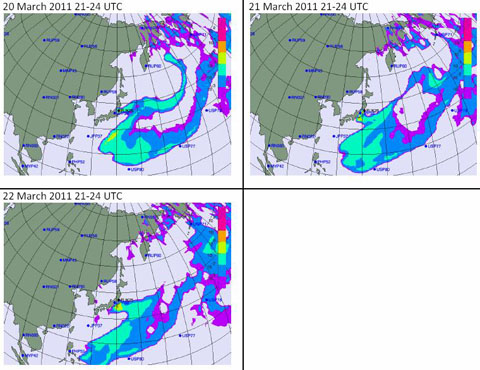Radioactive clouds spread near to the Philippines
Radioactive clouds due to incidents of nuclear plants from Japan are spreading to Southeast Asia, but do not affect Vietnam, nuclear experts and meteorologists said.
Monitoring data from the national data center of the Comprehensive Nuclear Test Ban Treaty (CTBTO) shows that radioactive clouds have spread to three regions of Southeast Asia, the Pacific and the Atlantic. Ocean.
" On March 22, the radioactive cloud will reach the northeastern part of the Philippine Islands, but it will be difficult to affect Vietnam, " the Ministry of Science and Technology announced yesterday.
The announcement by the Ministry of Science and Technology stressed that the CTBTO organization's Nuclear Radioactive Observatory network was built for the purpose of detecting nuclear explosion tests, so it is very sensitive and detectable. Very low radionuclides with high concentrations in the atmosphere and very low doses of radiation produced by these radionuclides do not affect human health.

Simulation of radioactive clouds on March 20, 21, 22 in Southeast Asia. Photo: Vaec.gov
Vietnam is not affected
As of yesterday afternoon, the environmental radiation monitoring and warning stations under the Ministry did not recognize the abnormal radioactive dispersal in Vietnam.
" Radioactivity font at 0.15 microsivert / hour measured in Hanoi and radioactivity figures of Da Lat Nuclear Research Institute are very normal ", Dr. Dang Thanh Luong, Deputy Director of Safety Department Nuclear radiation says.
Yesterday, in Hanoi, the Department of Radiation and Nuclear Safety measured radioactive isotopes for two Vietnamese people who were overseas students in Sendai, not seeing radiation.
The National Center for Meteorological and Hydrology also stated that Vietnam is not affected by ash and radioactivity due to the incident of nuclear power plant in Japan.
The Center's report explains, from March to May, that the wind circulation dominates the north of Asia as wind systems follow from west to east, so it is unlikely that the air masses will contain Dust and toxic substances (including radioactive dust) can be moved back to the West and Southwest to affect Southeast Asia and Vietnam.

Moving direction of current wind circulation. In the area of Vietnam, the wind faces the east
north. Graphic: National Hydro-meteorological Center.
According to the center, Vietnam is located far to the southwest of Japan and is located at a very low latitude compared to the location of Daiichi nuclear power plant in Fukushima (Northeastern Japan) so radioactive dust can't spread.
Currently, the incident of Fukushima I nuclear power plant is still under the control of the Japanese government. The pumping of seawater to cool the reactor and the tank of used fuel rods by specialized fire trucks has been effective. The temperature of the fuel storage tanks has decreased and the pressure of the reinforced concrete protection layer of unit 3 has also decreased.
- Radioactive clouds have not yet entered Vietnam
- Radioactive clouds spread to Hanoi
- Radioactive clouds covering Europe may originate from Russia
- How toxic is the radioactive cloud?
- Tomorrow, radioactive clouds come to Vietnam
- Radioactive clouds increase the nuclear level when coming to Southeast Asia
- Radioactive clouds near Quang Ninh
- Maybe contaminated clouds do not come to Vietnam
- Radioactive clouds near Ca Mau but not in Vietnam
- Radiation detection in leaves in Hanoi
- Tomorrow, radioactive clouds can cover Vietnam
- Radioactive clouds spread in the northern hemisphere
 Is the magnetic North Pole shift dangerous to humanity?
Is the magnetic North Pole shift dangerous to humanity? Washington legalizes the recycling of human bodies into fertilizer
Washington legalizes the recycling of human bodies into fertilizer Lightning stone - the mysterious guest
Lightning stone - the mysterious guest Stunned by the mysterious sunset, strange appearance
Stunned by the mysterious sunset, strange appearance